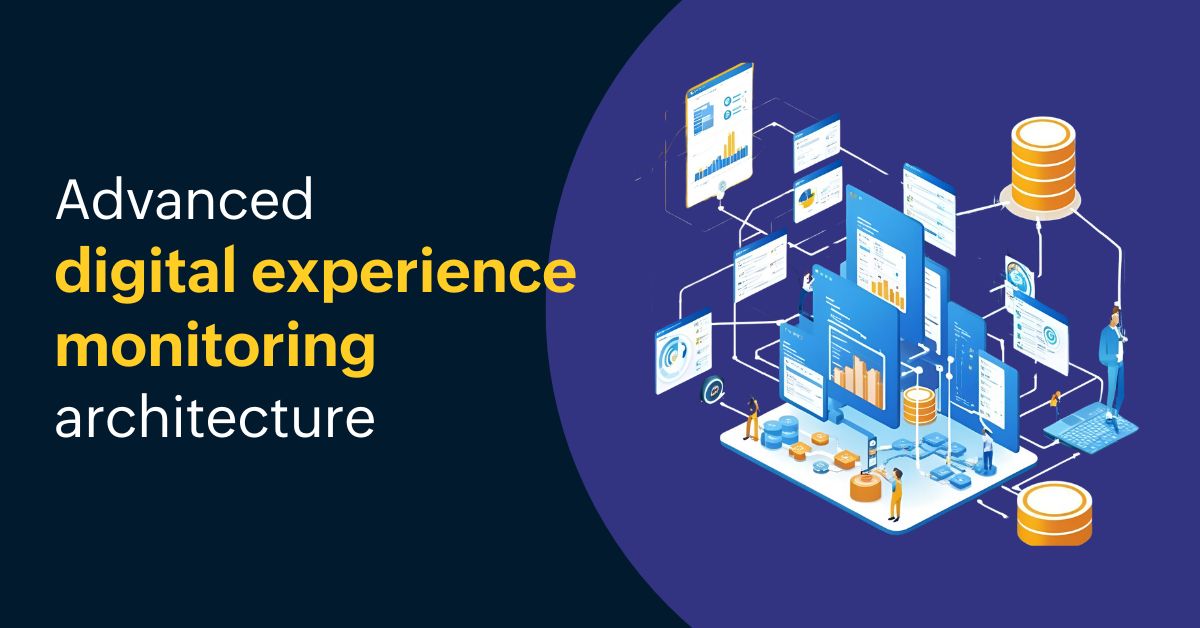Advanced architecture for digital experience monitoring in large enterprises

The difficulty, though, is in creating a system that can satisfy the particular requirements of big businesses. Monitoring becomes more difficult in large enterprises due to the sheer volume of individuals, devices, apps, and services involved. In addition to offering real-time warnings and predictive analytics, a well-architected digital experience monitoring solution must be able to measure performance across a variety of systems and geographical locations.
In this blog, we'll explore why and how advanced architectures are needed to monitor digital experiences at scale and how platforms like Site24x7 are rising to meet these needs.
What is an advanced DEM architecture?
It is a monitoring system that helps to maximise user experience across all digital touchpoints. It provides a comprehensive view of how consumers are interacting with websites, apps, and other digital platforms in addition to performance measurements. To improve customer satisfaction and corporate performance, the DEM tools places a heavy emphasis on data-driven decision-making, proactive issue resolution, and real-time analytics.
In an advanced DEM architecture, data obtained several sources will be collated on a single console making analysis and resolution smoother. Businesses can lower downtime and boost the value of their digital assets by being proactive. An equal emphasis is placed on detecting performance issues as well as determining their root causes and offering solutions.
Why large enterprises need advanced DEM architecture
Diverse digital ecosystems
Large companies typically manage an extensive digital asset network. It may be overwhelming to consider the vast number of endpoints that require monitoring, ranging from e-commerce platforms to cloud services and mobile apps. DEM solutions must be flexible and scalable in order to handle such variability.
For instance, a global e-commerce giant with applications deployed across multiple cloud providers, various mobile apps, and a complex web infrastructure might have to monitor the performance of each component, identify issues in real time, and track user experience metrics across all channels, and devices.
Global user base
Companies usually have customers and users from all over the world, and depending on where you are, the experience can vary. For instance, a slow-loading website in Asia may be the result of issues with the data center, server location, or network latency. Distributed monitoring is one way that a sophisticated DEM tool can handle this. Any organization with customers from across the globe, might find it important to gauge the performance of the page from multiple global locations.
Real-time and predictive analytics
While predictive analytics can foresee possible issues before they affect the user, real-time tracking is crucial for spotting and resolving problems as they arise. In order to proactively identify such issues, a strong DEM architecture should provide AI-powered insights that correlate performance indicators with user behavior. For instance, the data on the performance of the page when many users are using the site during a holiday season can be analysed throughout the time periods, patterns can be identified, and fixes can be done before it impacts the end users.
Integration with DevOps and IT Operations
Businesses that use modern DevOps approaches must have a smooth integration between operations workflows and monitoring solutions. DEM tools need to be able to interact with CI/CD pipelines, notify users during deployment processes, and ensure that any new releases don't negatively affect the user experience. The best architectures integrate with various monitoring systems to allow for the development of a single observability framework.
Take for instance a software company using a DevOps methodology to deploy updates to its flagship mobile application. They rely on automated CI/CD pipelines to deploy new features and bug fixes. A comprehensive DEM solution is integrated with their CI/CD pipeline. After every deployment, the DEM tool automatically runs performance tests across different devices and browsers. If a performance degradation is detected, the tool immediately notifies the development team, allowing the team to drill deep and fix the issues before reaches the end-user level.
Features of advanced DEM architecture
Synthetic and real-user monitoring
To gain complete visibility into the digital experience, an advanced DEM system should provide both synthetic and real-user monitoring. When synthetic monitoring simulates user interactions with your website or app to assess performance under various conditions, real-user monitoring (RUM) monitors interactions of actual users with the site providing insight into how they interact with your digital platforms in real-time.
A DEM tool like Site24x7 can seamlessly combine these monitoring practice to give you a comprehensive view of your user's journey. It helps you detect problems that synthetic testing might miss, such as slow response times or unexpected downtime caused by sudden user traffic spikes.
Global performance monitoring
DEM systems monitor performance at a global scale. By leveraging distributed monitoring points, businesses can analyze how users in various locations experience the same digital asset. Site24x7 offers global monitoring from over 130 locations worldwide , giving businesses granular insights into performance in any region.
Comprehensive dashboards
Analyzing and visualizing the data gathered from digital experience monitoring are equally crucial. Advanced DEM systems come with customizable dashboards that provide both historical and real-time data highlighting the KPIs like as page load speeds, error rates, uptime, and user satisfaction.With Site24x7's intuitive, personalized dashboard, which gathers all of your monitoring data in one place.
AI-powered insights
Enterprises can improve their ability to anticipate future performance difficulties and automate issue identification by utilizing AI. AI-powered features like anomaly detection and forecasting are included in Site24x7, which helps businesses save time and make better choices regarding their digital experience plans.
As we have seen, large businesses require more than simple website monitoring in the digital age. They require sophisticated, scalable architectures that are able to record every aspect of the user experience in a wide-ranging, international environment. Businesses may obtain the information they require to maximize performance, raise user satisfaction, and propel commercial success by implementing strong Digital Experience Monitoring solutions. Are you prepared to advance your digital experience tracking? Give Site24x7 a try now!